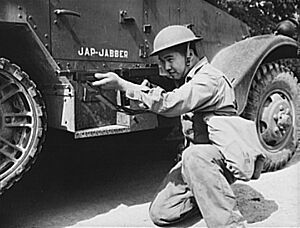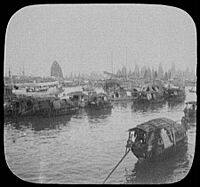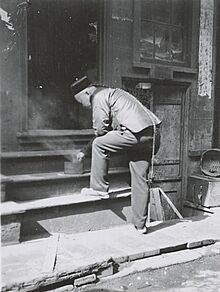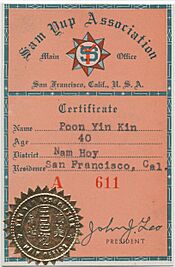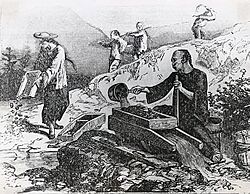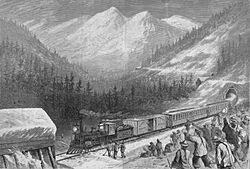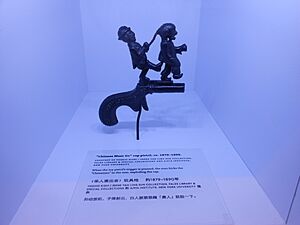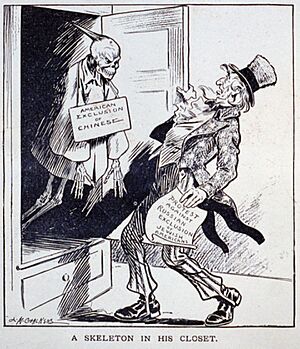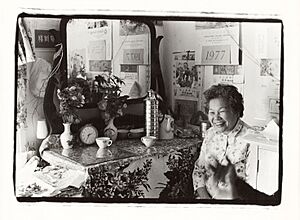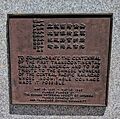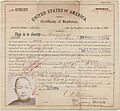History of Chinese Americans facts for kids
The history of Chinese Americans is the story of people of Chinese descent in the United States. This history includes three major waves of immigration, starting in the 1800s.
The first Chinese immigrants came to America in the 19th century. Many worked in the California Gold Rush in the 1850s and helped build the Central Pacific Railroad in the 1860s. They also worked in mines in the West. However, they faced a lot of unfair treatment and racial discrimination. Some people spread fearful ideas about them, and many groups worked against what they called "cheap Chinese labor."
Even though a treaty in 1868 was supposed to ensure fair treatment, the situation got worse. In 1882, the U.S. Congress passed the Chinese Exclusion Act. This law stopped most immigration from China for ten years and was later extended. It was the only U.S. law ever to prevent a specific group of people from immigrating and becoming citizens based on their race. These laws separated many families, as men who were already in the U.S. could not bring their wives and children from China.
For many years, laws made life very difficult for Chinese people in America. They were not allowed to become citizens or own land in many states. It wasn't until the 1940s, when the U.S. and China were allies in World War II, that things began to improve. In 1943, the Chinese Exclusion Repeal Act was passed, ending 61 years of official discrimination.
Large-scale Chinese immigration started again after 1965, when a new law removed limits based on where people came from. Since then, Chinese immigrants have become an important part of American society. Today, Chinese Americans are the largest ethnic group of Asian Americans. As of the 2020 U.S. census, there are more than 4.2 million Chinese Americans in the United States.
Contents
- Early Arrivals
- The First Big Wave of Immigration
- Important Jobs of Early Immigrants
- A Time of Unfairness: The Exclusion Era
- The Second Wave of Immigration (1940s–1980s)
- The Third Wave of Immigration (1980s to Today)
- Statistics of the Chinese Population in the United States (1850–2020)
- Images for kids
Early Arrivals
Chinese people first came to North America when Spain ruled parts of the continent. They worked as fishermen, sailors, and merchants on Spanish ships that sailed between the Philippines and Mexico.
After the American Revolutionary War, the United States began trading with China. American sailors met Chinese people in the port city of Canton (now Guangzhou) and told them about opportunities in America. The first Chinese people who came to the U.S. were mostly merchants, sailors, and students. Most did not plan to stay permanently.
American missionaries in China also sent some young Chinese boys to the U.S. to go to school. In 1854, Yung Wing became the first Chinese person to graduate from an American college, Yale University.
The First Big Wave of Immigration
The first major wave of Chinese immigration began in the 1850s. News of the California Gold Rush reached China, and many people wanted to travel to "Gam Saan," or "Gold Mountain," to make their fortune. Most of these immigrants were young men from the Guangdong province in southern China. They were also escaping poverty and conflict back home.
Between 1850 and 1882, about 300,000 Chinese people arrived in the United States. They not only searched for gold but also helped build the First Transcontinental Railroad, worked on farms in the South, and helped create California's farming and fishing industries.
From the moment they arrived, they faced racism from many European settlers. They were often forced to live in separate neighborhoods that became known as Chinatowns. Unfair laws were passed against them, including special taxes that only they had to pay.
Coming to America
Most Chinese immigrants borrowed money from family or associations to pay for their trip across the Pacific Ocean. The journey was long and difficult. When they arrived in cities like San Francisco, they faced many challenges. They did not speak English and were unfamiliar with American culture.
The unfair treatment they faced made it hard for them to become part of American society. To support each other, they formed associations. These groups helped newcomers find jobs, housing, and a sense of community.
Another challenge was their appearance. At that time, the government in China required all Han Chinese men to shave the front of their heads and wear the rest of their hair in a long braid called a queue. Because most immigrants planned to return to China to see their families, they could not cut their queues.
Most of the first immigrants were men. It was expensive to travel, and there were few job opportunities for women. Also, many men worried that their families would face the same discrimination they did. This meant that for many years, the Chinese American community was mostly made up of men.
Building Communities
To deal with the challenges of a new country, Chinese immigrants created their own support networks. They formed associations based on the districts or family clans they came from in China. These groups provided important services, like finding jobs, offering loans, and providing legal help.
In San Francisco, several of these groups joined together to form the Chinese Consolidated Benevolent Association (CCBA), also known as the "Chinese Six Companies." The CCBA became a powerful voice for the Chinese community. It fought against discriminatory laws and took cases to court, even to the Supreme Court, to protect the rights of Chinese Americans.
Important Jobs of Early Immigrants
The California Gold Rush
The California Gold Rush drew thousands of Chinese immigrants to America in the 1850s. They called California "Gold Mountain." In the goldfields, they often faced violence and unfair treatment from white miners.
To protect themselves, Chinese miners worked in large, organized groups. This teamwork often helped them find more gold than miners who worked alone. They also worked in areas that others had given up on, patiently finding the gold that was left behind.
However, as gold became harder to find, other miners became more hostile. The California government passed a "Foreign Miners' Tax" in 1852, which was aimed mostly at Chinese miners. They had to pay a special tax each month, which was a lot of money at the time. In 1854, the California Supreme Court ruled that Chinese people could not testify in court against white people. This decision made it impossible for them to get justice if they were robbed or attacked.
Building the Transcontinental Railroad
After the Gold Rush, many Chinese workers found jobs building the first transcontinental railroad. This railroad connected the East and West coasts of the United States for the first time. The work was incredibly difficult and dangerous, especially the part that went through the Sierra Nevada mountains.
The manager of the Central Pacific Railroad, Charles Crocker, hired thousands of Chinese immigrants because there were not enough other workers. These men worked long hours for low pay, blasting tunnels through solid granite and laying track in extreme heat and freezing cold. Many lost their lives in accidents and avalanches.
Despite the harsh conditions, the Chinese workers were known for being hardworking and reliable. At the peak of construction, more than 11,000 Chinese laborers were working on the railroad. Their incredible effort was essential to completing one of the greatest engineering achievements in American history.
Farming and Fishing

Many Chinese immigrants were experienced farmers. They used their skills to help turn California into a major agricultural state. They were especially important in the Sacramento-San Joaquin River Delta, where they built miles of levees (walls of earth) to turn marshland into fertile farmland.
Chinese immigrants also started a successful fishing industry on the West Coast. They caught fish, crabs, and other seafood, which they sold in local markets or dried and shipped to other places. However, just like in the gold mines, they soon faced unfair laws and taxes designed to push them out of the business.
A Time of Unfairness: The Exclusion Era
In the 1870s, the U.S. economy struggled, and many people lost their jobs. Some groups unfairly blamed Chinese immigrants for taking jobs and lowering wages. This led to a strong anti-Chinese movement, especially in the West. The slogan "The Chinese must go!" became popular.
This movement led to violence against Chinese communities and pushed politicians to take action.
The Chinese Exclusion Act
In 1882, Congress passed the Chinese Exclusion Act. This law did two main things:
- It stopped most Chinese workers from immigrating to the United States.
- It said that Chinese people already living in the U.S. could not become citizens.
This was a turning point in American history. It was the first time the U.S. had passed a law to block a specific ethnic group from immigrating. The law was renewed several times and was not repealed until 1943. For over 60 years, it caused great hardship and separated many families.
During this time, Chinese Americans continued to fight for their rights in court. In one famous case, United States v. Wong Kim Ark (1898), the Supreme Court ruled that a person born in the United States is automatically a U.S. citizen, even if their parents are not. This is an important rule that still applies today.
The Second Wave of Immigration (1940s–1980s)
The situation for Chinese Americans began to change during World War II. China was an ally of the United States in the war, which helped reduce some of the anti-Chinese feelings. In 1943, Congress passed the Magnuson Act, which finally ended the Chinese Exclusion Act.
This new law allowed Chinese immigrants to become citizens for the first time. However, it still set a very low limit on how many people could come from China each year—only 105.
The biggest change came with the Immigration and Nationality Act of 1965. This law got rid of the old system that favored immigrants from Europe. It opened the door for many more people from Asia, including China, to come to the United States. During this period, many immigrants came from Taiwan and Hong Kong.
The Third Wave of Immigration (1980s to Today)
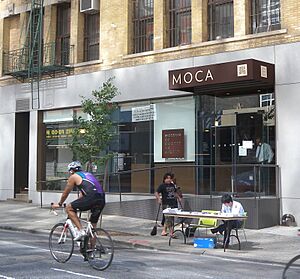
Since the 1980s, a third wave of immigrants has arrived, mostly from mainland China. Many of these newcomers are students and professionals. They have settled in cities and suburbs across the country.
Today, Chinese Americans are a diverse and growing community. They have made important contributions in every field, from science and technology to art and business. They continue to be a vital part of the American story, adding to the nation's rich cultural mix.
Statistics of the Chinese Population in the United States (1850–2020)
The table shows how the Chinese American population has grown over time.
| Year | Total U.S. population | Of Chinese origin | Percentage |
|---|---|---|---|
| 1850 | 23,191,876 | 4,018 | 0.02% |
| 1860 | 31,443,321 | 34,933 | 0.11% |
| 1870 | 38,558,371 | 64,199 | 0.17% |
| 1880 | 50,189,209 | 105,465 | 0.21% |
| 1890 | 62,979,766 | 107,488 | 0.17% |
| 1900 | 76,212,168 | 118,746 | 0.16% |
| 1910 | 92,228,496 | 94,414 | 0.10% |
| 1920 | 106,021,537 | 85,202 | 0.08% |
| 1930 | 123,202,624 | 102,159 | 0.08% |
| 1940 | 132,164,569 | 106,334 | 0.08% |
| 1950 | 151,325,798 | 150,005 | 0.10% |
| 1960 | 179,323,175 | 237,292 | 0.13% |
| 1970 | 203,302,031 | 436,062 | 0.21% |
| 1980 | 226,542,199 | 812,178 | 0.36% |
| 1990 | 248,709,873 | 1,645,472 | 0.66% |
| 2000 | 281,421,906 | 2,432,585 | 0.86% |
| 2010 | 308,745,538 | 3,794,673 | 1.23% |
| 2020 | 331,449,281 | 5,400,000 | 1.6% |
Images for kids


